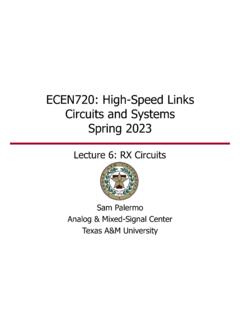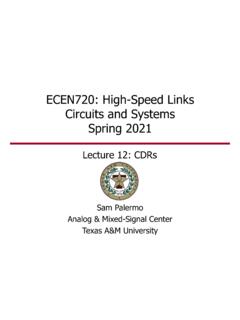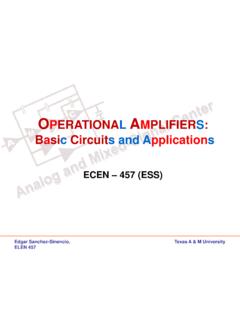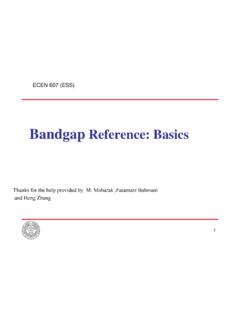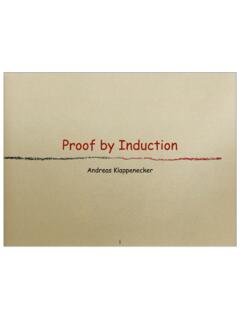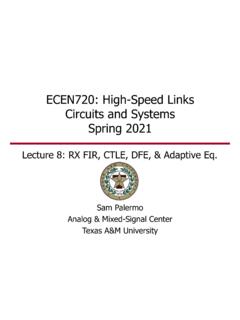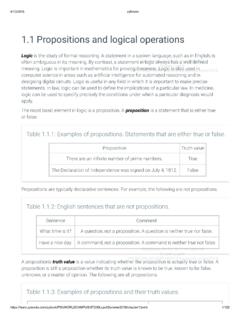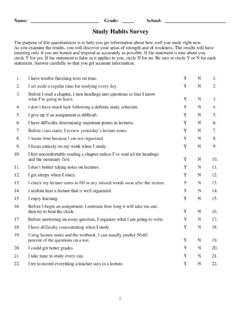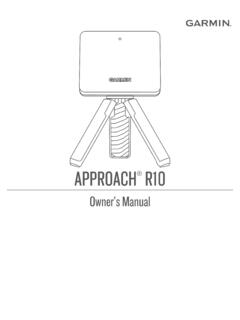Transcription of ECEN720: High-Speed Links Circuits and Systems Spring 2021
1 Sam PalermoAnalog & Mixed-Signal CenterTexas A&M UniversityECEN720: High-Speed Links Circuits and SystemsSpring 2021 Lecture 5: Termination, TX Driver, & Multiplexer CircuitsAnnouncements Lab 3 Report and Prelab 4 due Feb. 26 Reading Papers posted on voltage-mode drivers and high-order TX multiplexer circuits2 Agenda Termination Circuits TX Driver Circuits TX circuit speed limitations Clock distribution Multiplexing techniques3 High-Speed Electrical Link System4 Termination Off-chip vs on-chip Series vs parallel DC vs AC Coupling Termination circuits5 Off-Chip vs On-Chip Termination6 Package parasitics act as an unterminated stub which sends reflections back onto the line On-chip termination makes package inductance part of transmission line[Dally]Series vs Parallel Termination7 Series TerminationParallel TerminationDouble Termination Low impedance voltage-mode driver typically employs series termination High impedance current-mode driver typically employs parallel termination Double termination yields best signal quality Done in majority of high performance serial linksAC vs DC Coupled Termination8 DC coupling allows for uncoded data RX common-mode set by transmitter signal level AC coupling allows for independent RX common-mode level Now channel has low frequency cut-off Data must be codedRX Common-Mode = IR/2RX Common-Mode = VTTP assive Termination Choice of integrated resistors involves trade-offs in manufacturing steps, sheet resistance, parasitic capacitance, linearity.
2 And ESD tolerance Integrated passive termination resistors are typically realized with unsalicided poly, diffusion, or n-well resistors Poly resistors are typically used due to linearity and tighter tolerances, but they typically vary +/-30% over process and temperature9 ResistorPolyN-diffusionN-wellSheet R ( /sq)90 10300 50450 200VC1(V-1)010-38x10-3 Parasitic Cap2-3fF/um2(min L poly) (area), (perimeter) (area), (perimeter)Resistor Options (90nm CMOS)Active Termination Transistors must be used for termination in CMOS processes which don t provide resistors Triode-biased FET works well for low- swing (<500mV) Adding a diode connected FET increases linear range Pass-gate structure allows for differential termination 10[Dally]Adjustable Termination FET resistance is a function of gate overdrive11 tGSoxFETVVLWCR 1 Large variance in FET threshold voltage requires adjustable termination structures Calibration can be done with an analog control voltage or through digital trimming Analog control reduces VGSand linear range Digital control is generally preferred[Dally]
3 Termination Digital Control Loop Off-chip precision resistor is used as reference On-chip termination is varied until voltages are within an LSB Dither filter typically used to avoid voltage noise Control loop may be shared among several Links , but with increased nanometer CMOS variation per-channel calibration may be necessary12[Dally] High-Speed Electrical Link System13TX Driver Circuits Single-ended vs differential signaling Controlled-impedance current & voltage-mode drivers swing enhancement techniques Impedance control Pad bandwidth extension Slew-rate control14 Single-Ended Signaling Finite supply impedance causes significant Simultaneous Switching Output (SSO) noise (xtalk) Necessitates large amounts of decoupling capacitance for supplies and reference voltage Decap limits I/O area more that circuitry15 Differential Signaling A difference between voltage or current is sent between two lines Requires 2x signal lines relative to single-ended signaling, but less return pins Advantages Signal is self-referenced Can achieve twice the signal swing Rejects common-mode noise Return current is ideally only DC16[Sidiropoulos]TX Driver Circuits Single-ended vs differential signaling Controlled-impedance current & voltage-mode drivers swing enhancement techniques Impedance control Pad bandwidth extension Slew-rate control17 Controlled-Impedance Drivers Signal integrity considerations (min.)
4 Reflections) requires 50 driver output impedance To produce an output drive voltage Current-mode drivers use Norton-equivalent parallel termination Easier to control output impedance Voltage-mode drivers use Thevenin-equivalent series termination Potentially to the current for a given output swing18D+D-2 VSWVZ contD+D-Push-Pull Current-Mode Driver19 Used in Low-Voltage Differential Signals (LVDS) standard Driver current is ideally constant, resulting in low dI/dt noise Dual current sources allow for good PSRR, but headroom can be a problem in low-voltage technologies Differential peak-to-peak RX swing is IR with double terminationCurrent-Mode Logic (CML) Driver20 Used in most high performance serial Links Low voltage operation relative to push-pull driver High output common-mode keeps current source saturated Can use DC or AC coupling AC coupling requires data coding Differential pp RX swing is IR/2 with double terminationCurrent-Mode Current Levels21 RIVd21, Single-Ended TerminationDifferential Termination RIVd241, RIVd20, RVIppd, IRVppd, RIVd240, RVIppd, IRVppd,Voltage-Mode Current Levels22 21,sdVV Single-Ended TerminationDifferential Termination 21,sdVV 20,sdVV 2 RVIppd, RVIVV ssppd2, 20,sdVV 4 RVIppd, RVIVV ssppd4.
5 Current-Mode vs Voltage-Mode Summary An ideal voltage-mode driver with differential RX termination enables a potential4x reduction in driver power Actualdriver power levels also depend on Output impedance control Pre-driver power Equalization implementation23 Driver/TerminationCurrent LevelNormalized Current LevelCurrent-Mode/SEVd,pp/Z01xCurrent-Mo de/DiffVd,pp/Z01xVoltage-Mode/SEVd, , Voltage-mode driver implementation depends on output swing requirements For low- swing (<400-500mVpp), an all NMOS driver is suitable For high- swing , CMOS driver is usedVoltage-Mode Drivers24 Term) (SE 2 Term) (Diff. 341111 ODtsODtsVVVDDVVVVDDV 11 ODtsVVV Low- swing Voltage-Mode DriverHigh- swing Voltage-Mode DriverDinDinM1M0 VsTX Driver Circuits Single-ended vs differential signaling Controlled-impedance current & voltage-mode drivers swing enhancement techniques Impedance control Pad bandwidth extension Slew-rate control25 High- swing Transmitter Linearity Transmit swings 1 Vppdare often needed to support operation over high-loss channels Reductions in supply voltages make achieving this swing with high linearity difficult This is particularly important with PAM4 modulation26 Parallel Bleeder Current Source Parallel thick-oxide bleeder current source from supply raises output common mode Achieves > in a 16nm FinFET process27 Upadhyaya.
6 VLSI 2016 CML Driver w/ Higher Output Stage Supply28CK0 DCK90 VbiasVCC_HVVCC_NOMVcs=~1 VPGenESDESDKim, ISSCC 2018 Higher output stage supply Source voltage of switch PMOS transistors remains near 1V for 10nm reliability >1 VppdswingTail-Less Current-Mode Driver29 Bottom transistor driven by full-rate serialized data Replica-bias network sets output stage cascode transistors gate voltage to achieve the desired output swing Achieves swing with 94% RLM[Steffan ISSCC 2017]Voltage-Mode Driver w/ Level-Shifting Predriver30 Predriver uses a supply to drive the NMOS and a level shifted GND to drive the PMOS Achieves 1 Vppdoutput swing in 7nm CMOS[Ali ISSCC 2019]Hybrid Voltage-Mode Driver w/ Parallel Current-Mode Segments31 Parallel current-mode output stage provides swing enhancement Achieves swing in 40nm CMOS[Joy ISSCC 2011]PAM4 Hybrid Voltage-Mode Driver w/ Parallel Push-Pull Current-Mode Segments32 Parallel push-pull current sources driven by the MSB & LSB allow for a high- swing PAM4 implementation Achieves swing in 1V 28nm CMOS with >94% RLM[Bassi JSSC 2016]
7 Low-Speed Operation45Gb/sTX Driver Circuits Single-ended vs differential signaling Controlled-impedance current & voltage-mode drivers swing enhancement techniques Impedance control Pad bandwidth extension Slew-rate control33 Global Resistor Calibration34 Off-chip precision resistor is used as reference On-chip termination is varied until voltages are within an LSB Dither filter typically used to avoid voltage noise In current-mode drivers, this code is used for the nominal load setting[Chan ASSCC 2016]Low- swing VM Driver Impedance Control35 A linear regulator sets the output stage supply, Vs Termination is implemented by output NMOS transistors To compensate for PVT and varying output swing levels, the pre-drive supply is adjusted with a feedback loop The top and bottom output stage transistors need to be sized differently, as they see a different VOD[Poulton JSSC 2007]4:1 Output Multiplexing Voltage-Mode Song, R.
8 Bai, P. Chiang, and S. Palermo, A , I/OTransceiver in 65nm-CMOS, IEEE JSSC, vol. 48,no. 5, pp. 1276-1289, May ShifterLevel ShifterDFFD QQ8:4CK0CK180CK0CK0 PulseGeneratorTXPTXNVZDNCKPCKNT xdataCK180CK90CK270CP0CP90CP180CP2702Gb/ s8Gb/s2 GHz8x1Gb/s/2CK0/90/180/270CP0/90/180/270 Scalable VCdec4:1 Voltage Mode Output Driver2 Stages PPFCML to CMOS ConverterScalable DVDD8:4 MUX, AND Gate, and Level ShifterIQBQIBERRORAMP Impedance control is achieved independent of the pre-driver supply by adding additional up/down analog-controlled NMOS transistors Level-shifting pre-driver allows for smaller output transistorsLow- swing Voltage-Mode Driver Analog Impedance Song, R. Bai, P. Chiang, and S. Palermo, A , I/OTransceiver in 65nm-CMOS, IEEE JSSC, vol. 48,no. 5, pp. 1276-1289, May 2013.
9 Replica global impedance control loop provides analog gate voltages to the additional top/bottom transistors to set the pull-up/down impedanceHigh- swing Voltage-Mode Driver Impedance Control38 Passive resistors + transistors triode resistance Output impedance will change due to process variation Causes reflection and level mismatchVDDR termRtermMNMPInOutHigh- swing Voltage-Mode Driver Impedance Control39 Equalization control by setting the number of segments connected to each tap Termination control by setting the total number of enabled segments Disadvantages: Transistor stacking in full-rate path Extra area due to redundant segments Extra power consumption because pre-driver should be sized to drive maximum load Sensitive to P/N skew variationsHigh- swing Voltage-Mode Driver Hybrid Impedance Control Scheme40 Programmable number of driver slices provides coarse impedance control to compensate for resistor variations Analog impedance loop provides fine impedance control to compensate for NMOS/PMOS variations Measured differential mode return loss meets key protocols composite return loss maskAnalog Impedance Loop75 to 85driver slices (10 programmable slices with NAND and NOR as pre-driver)
10 [Chan ASSCC 2016]TX Driver Circuits Single-ended vs differential signaling Controlled-impedance current & voltage-mode drivers swing enhancement techniques Impedance control Pad bandwidth extension Slew-rate control41 Output Pad Network Challenges Meeting return loss (S11) spec <-7dB at Nyquist Maximizing bandwidth with small group delay Support ESD Balance output network size versus performance42T-Coil Output Stage Output T-coil between driver and pad allows for splitting of driver, ESD, and pad capacitance Provides significant bandwidth enhancement and improved return loss43[Kossel JSSC 2008]T-Coil Equations44[Kossel JSSC 2008]Output Reflection FactorT-Coil Wiring & Improvement A helical wiring scheme reduces the vertical parasitic fringing capacitance between layers and improves self-resonance frequency45[Kossel JSSC 2008]P1P2P3TX w/ T-coil/ESDESD, no T-coilNo ESD or T-coilHFSS modelEq.
